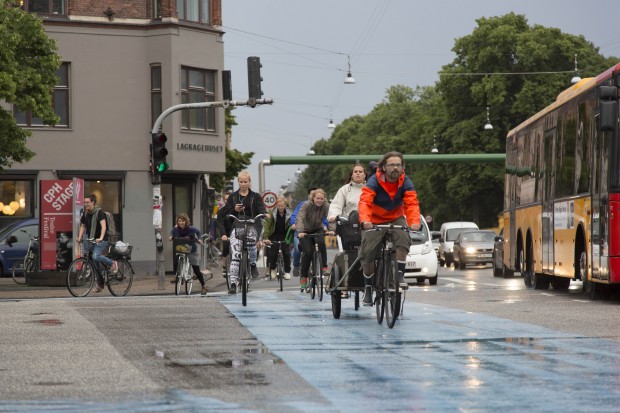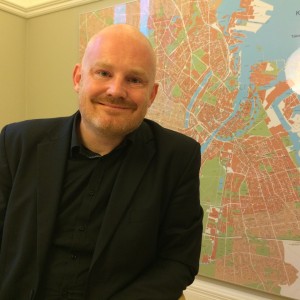Copenhagen Turns to Two Wheels and Takes Off

DPA /LANDOV
Cyclist commuting in the Copenhagen neighborhood of Norrebro.
Rain or shine, in the light of summer or the early afternoon darkness of winter, under heavy sleet, unrelenting winds or drifts of snow, people in Copenhagen just bike. They bike in fur coats, they bike in suits and ties. They bike old, they bike young. They wheel their kids around on a cargo bike with a wooden box carrying the children up front, taking them to and from school; this is Copenhagen’s take on a minivan. People just bike, and after arriving in the city myself, I soon found out why: it’s usually the fastest way to get around. So I rented a bike, too.
Today, 60 percent of people in the city’s core commute by bike. In the greater Copenhagen area, over 40 percent do. “We see the same numbers [of commuting by bike] all year round,” says Copenhagen Environmental and Technical Affairs Mayor Morten Kabell.
“It’s not something that’s in Copenhagen’s genes, or that we’re weirder or stranger than any other people on earth,” Kabell says. “Every city can do this.”
Copenhagen has had enormous success getting people out of their cars and onto bikes, public transit and their own two feet. But this development has less to do with Danes wanting to save the planet, and much more to do with saving their own sanity.
Yes, Copenhagen has an ambitious goal to become the first carbon-neutral capital within a decade. It faces serious risks from rising sea levels and intense rains called cloudbursts, which have intensified in recent years. The city is about halfway towards its goal of becoming carbon-neutral, a feat accomplished by shifting it’s power sources from coal and fossil fuels to wind, hydropower and biomass. It’s increased its energy efficiency, innovation and recycling, and was given the European Green Capital Award this year for its efforts.
But that’s not why so many people here bike. That shift dates back to before climate change was really on the public’s mind.

"You can sit in your metal box and be cut off from the rest of the world, or you can get out there on your feet or on your bicycle and actually interact with the other people in the city," Copenhagen Environmental and Technical Affairs Mayor Morten Kabell says.
“A hundred years ago, we built our first bicycle track,” Kabell says. It was a system that separated the street into three layers, one for pedestrians, one for bicycles, and the other for cars. But it didn’t take off, because getting around by car was easier.
“In the fifties and sixties, if you saw Copenhagen, you wouldn’t find many bicycles,” Kabell says. “Cars dominated the whole urban area, just like in most American cities. Then it changed.”
What changed was traffic. The dense, compact city was growing then as it is now, and simply reached a breaking point: there wasn’t enough room for all the cars to get around. At one point it got so bad that the city council actually approved building a highway over the beautiful royal lakes that ring the city. That got people’s attention.
“Copenhageners stood up,” Kabell says. “They demanded at city council to get change. They wanted their squares back! They wanted their streets back! They wanted to send their kids off to school on a bicycle alone instead of having to drive them in their car. They didn’t do it because they were ideologically driven, they did it because they wanted an easier city.”
So they looked backward, to before the automobile, and opted for two wheels instead of four. Bike lanes were put in all over the city; in recent years, dedicated bike highways have connected neighborhoods further and further out into the city as well. Every street in the city is examined to become better for bikes and pedestrians. And today, those lakes that almost became a highway are a featured scenic attraction of the city, a popular place for strolling and cycling.
“There’s a difference in the way we interact,” Kabell says. “You can sit in your metal box and be cut off from the rest of the world, or you can get out there on your feet or on your bicycle and actually interact with the other people in the city.”
Kabell’s post at City Hall originally came with it’s own car and driver. He turned it down, and got an e-bike instead that he uses for his daily work. It’s his ‘Mayoral Bike,’ and Kabell says he usually gets to meetings faster than other officials traveling by car. His own commute went from a half-hour in the car to just under ten minutes by e-bike. (Kabell is one of several mayors in the city; his office deals with climate change initiatives, the environment, urban development and design and traffic.)
Copenhagen certainly has attributes that allow it to embrace biking more easily than many American cities, chief among them its density. But Kabell says what’s been accomplished here can be done elsewhere.
“It can be done,” he says. “Even if you only move two or three percent of car drivers onto bicycles, then you’re still getting rid of two or three percent of cars off the streets. It makes it easier for everyone to commute, and makes for a greener, healthier city. You don’t have to say, ‘We need to better than Copenhagen,’ you just need to say, ‘We want to get started.'”